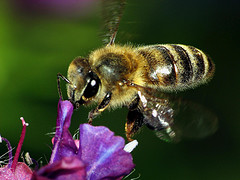Bees are probably best known for producing honey, but their most important contribution to the world is really through their pollination services. Worker bees work endlessly to perform the activities to keep the hive going. At different stages of their life cycle, worker bees are ‘nurse bees’, caring for the larvae and tending the queen and then ‘foraging bees’ collecting nectar to make honey, and pollen to feed the brood.

Pollination in action!
By doing this foraging, they carry out a very large proportion of all the insect pollination needed by plants and flowers to reproduce (up to 80% of all insect pollination is by honey bees). Over 100 crops are pollinated by bees, including fruits, vegetables, nuts and seeds. It is estimated that honey bees are is responsible for one third of all the food we eat.
So the honey bee is an incredibly important part of the natural food chain. But it recently has seen a serious decline in numbers, most notably in North America. Up to one third of honey bees have mysteriously disappeared, in a phenomenon dubbed colony collapse disorder (or CCD).
It is not known exactly what is causing these losses, but ironically some of this decline is probably caused by is the relentless transportation of bees around the country to pollinate crops.

Beehives being transported for pollination
Sharing bees in an effort to boost crop production is big business today. Many farmers and growers are totally dependent on commercial bee farmers bringing in large numbers of colonies to pollinate their crops. These bees are left for a few weeks, and then transported on to the next orchard or plantation. This process continues throughout much of the season, with bees being transported thousands of miles every year.
Such intensive production methods are increasingly coming under scrutiny, both in terms of the monoculture and its effect on the local environment, but also in terms of the stress placed on the bees.
Scientists are now studying the full effects this regular transport has had on the bees. Many are worried that the stress might leave them open to infection and disease. It certainly does seem to have coincided with the massive drop in bee numbers. And recent research suggests that a likely cause of CCD is a combination of the varroa mite (a parasitic mite that infests bee colonies) and nosema (a disease caused by a parasite in the bee gut). Bees are much more prone to both of these problems when subject to stress.
The full causes of CCD are not yet known, and maybe never will be. But it is likely that the industrialization of agriculture is at least partly to blame. No reports of CCD have yet been recorded among natural beekeepers, and this tells a tale in itself.
Pollination image courtesy Gustavo
